[English] 日本語
 Yorodumi
Yorodumi- PDB-7daa: Crystal structure of basigin complexed with anti-basigin Fab fragment -
+ Open data
Open data
- Basic information
Basic information
| Entry | Database: PDB / ID: 7daa | |||||||||||||||||||||
|---|---|---|---|---|---|---|---|---|---|---|---|---|---|---|---|---|---|---|---|---|---|---|
| Title | Crystal structure of basigin complexed with anti-basigin Fab fragment | |||||||||||||||||||||
 Components Components |
| |||||||||||||||||||||
 Keywords Keywords | CHAPERONE / Basigin / Fab / antibody / complex | |||||||||||||||||||||
| Function / homology |  Function and homology information Function and homology informationDefective SLC16A1 causes symptomatic deficiency in lactate transport (SDLT) / Proton-coupled monocarboxylate transport / positive regulation of matrix metallopeptidase secretion / dendrite self-avoidance / acrosomal membrane / cell-cell adhesion mediator activity / endothelial tube morphogenesis / response to mercury ion / neural retina development / photoreceptor cell maintenance ...Defective SLC16A1 causes symptomatic deficiency in lactate transport (SDLT) / Proton-coupled monocarboxylate transport / positive regulation of matrix metallopeptidase secretion / dendrite self-avoidance / acrosomal membrane / cell-cell adhesion mediator activity / endothelial tube morphogenesis / response to mercury ion / neural retina development / photoreceptor cell maintenance / Basigin interactions / Aspirin ADME / odontogenesis of dentin-containing tooth / homophilic cell-cell adhesion / D-mannose binding / decidualization / positive regulation of vascular endothelial growth factor production / photoreceptor outer segment / response to cAMP / Integrin cell surface interactions / Degradation of the extracellular matrix / neutrophil chemotaxis / photoreceptor inner segment / positive regulation of endothelial cell migration / embryo implantation / axon guidance / protein localization to plasma membrane / response to peptide hormone / sarcolemma / positive regulation of interleukin-6 production / melanosome / signaling receptor activity / virus receptor activity / angiogenesis / basolateral plasma membrane / positive regulation of viral entry into host cell / cell surface receptor signaling pathway / endosome / cadherin binding / axon / Golgi membrane / focal adhesion / endoplasmic reticulum membrane / mitochondrion / extracellular exosome / membrane / plasma membrane Similarity search - Function | |||||||||||||||||||||
| Biological species |  Homo sapiens (human) Homo sapiens (human) | |||||||||||||||||||||
| Method |  X-RAY DIFFRACTION / X-RAY DIFFRACTION /  SYNCHROTRON / SYNCHROTRON /  MOLECULAR REPLACEMENT / Resolution: 2.51 Å MOLECULAR REPLACEMENT / Resolution: 2.51 Å | |||||||||||||||||||||
 Authors Authors | Sakuragi, T. / Kanai, R. / Narita, H. / Onishi, E. / Miyazaki, T. / Baba, T. / Nakagawa, A. / Toyoshima, C. / Nagata, S. | |||||||||||||||||||||
| Funding support |  Japan, 6items Japan, 6items
| |||||||||||||||||||||
 Citation Citation |  Journal: Nat Struct Mol Biol / Year: 2021 Journal: Nat Struct Mol Biol / Year: 2021Title: The tertiary structure of the human Xkr8-Basigin complex that scrambles phospholipids at plasma membranes. Authors: Takaharu Sakuragi / Ryuta Kanai / Akihisa Tsutsumi / Hirotaka Narita / Eriko Onishi / Kohei Nishino / Takuya Miyazaki / Takeshi Baba / Hidetaka Kosako / Atsushi Nakagawa / Masahide Kikkawa / ...Authors: Takaharu Sakuragi / Ryuta Kanai / Akihisa Tsutsumi / Hirotaka Narita / Eriko Onishi / Kohei Nishino / Takuya Miyazaki / Takeshi Baba / Hidetaka Kosako / Atsushi Nakagawa / Masahide Kikkawa / Chikashi Toyoshima / Shigekazu Nagata /  Abstract: Xkr8-Basigin is a plasma membrane phospholipid scramblase activated by kinases or caspases. We combined cryo-EM and X-ray crystallography to investigate its structure at an overall resolution of 3. ...Xkr8-Basigin is a plasma membrane phospholipid scramblase activated by kinases or caspases. We combined cryo-EM and X-ray crystallography to investigate its structure at an overall resolution of 3.8 Å. Its membrane-spanning region carrying 22 charged amino acids adopts a cuboid-like structure stabilized by salt bridges between hydrophilic residues in transmembrane helices. Phosphatidylcholine binding was observed in a hydrophobic cleft on the surface exposed to the outer leaflet of the plasma membrane. Six charged residues placed from top to bottom inside the molecule were essential for scrambling phospholipids in inward and outward directions, apparently providing a pathway for their translocation. A tryptophan residue was present between the head group of phosphatidylcholine and the extracellular end of the path. Its mutation to alanine made the Xkr8-Basigin complex constitutively active, indicating that it plays a vital role in regulating its scramblase activity. The structure of Xkr8-Basigin provides insights into the molecular mechanisms underlying phospholipid scrambling. | |||||||||||||||||||||
| History |
|
- Structure visualization
Structure visualization
| Structure viewer | Molecule:  Molmil Molmil Jmol/JSmol Jmol/JSmol |
|---|
- Downloads & links
Downloads & links
- Download
Download
| PDBx/mmCIF format |  7daa.cif.gz 7daa.cif.gz | 114.1 KB | Display |  PDBx/mmCIF format PDBx/mmCIF format |
|---|---|---|---|---|
| PDB format |  pdb7daa.ent.gz pdb7daa.ent.gz | 84.8 KB | Display |  PDB format PDB format |
| PDBx/mmJSON format |  7daa.json.gz 7daa.json.gz | Tree view |  PDBx/mmJSON format PDBx/mmJSON format | |
| Others |  Other downloads Other downloads |
-Validation report
| Arichive directory |  https://data.pdbj.org/pub/pdb/validation_reports/da/7daa https://data.pdbj.org/pub/pdb/validation_reports/da/7daa ftp://data.pdbj.org/pub/pdb/validation_reports/da/7daa ftp://data.pdbj.org/pub/pdb/validation_reports/da/7daa | HTTPS FTP |
|---|
-Related structure data
| Related structure data | 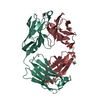 7d9zSC 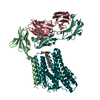 7dceC S: Starting model for refinement C: citing same article ( |
|---|---|
| Similar structure data |
- Links
Links
- Assembly
Assembly
| Deposited unit | 
| ||||||||
|---|---|---|---|---|---|---|---|---|---|
| 1 |
| ||||||||
| Unit cell |
|
- Components
Components
| #1: Protein | Mass: 19592.814 Da / Num. of mol.: 1 / Mutation: N152Q, N186Q Source method: isolated from a genetically manipulated source Source: (gene. exp.)  Homo sapiens (human) / Gene: BSG, UNQ6505/PRO21383 / Production host: Homo sapiens (human) / Gene: BSG, UNQ6505/PRO21383 / Production host:  | ||||
|---|---|---|---|---|---|
| #2: Antibody | Mass: 23319.902 Da / Num. of mol.: 1 Source method: isolated from a genetically manipulated source Source: (gene. exp.)  Homo sapiens (human) / Production host: Homo sapiens (human) / Production host:  Homo sapiens (human) Homo sapiens (human) | ||||
| #3: Antibody | Mass: 22786.523 Da / Num. of mol.: 1 Source method: isolated from a genetically manipulated source Source: (gene. exp.)  Homo sapiens (human) / Production host: Homo sapiens (human) / Production host:  Homo sapiens (human) Homo sapiens (human) | ||||
| #4: Chemical | ChemComp-CD / Has ligand of interest | N | Has protein modification | Y | |
-Experimental details
-Experiment
| Experiment | Method:  X-RAY DIFFRACTION / Number of used crystals: 1 X-RAY DIFFRACTION / Number of used crystals: 1 |
|---|
- Sample preparation
Sample preparation
| Crystal | Density Matthews: 2.89 Å3/Da / Density % sol: 57.37 % |
|---|---|
| Crystal grow | Temperature: 293.15 K / Method: vapor diffusion, sitting drop Details: 0.1M Tris-HCl (pH 8.0) buffer containing 0.1M sodium chloride, 0.1M cadmium chloride hemi(pentahydrate), 33% PEG 400 |
-Data collection
| Diffraction | Mean temperature: 100 K / Serial crystal experiment: N |
|---|---|
| Diffraction source | Source:  SYNCHROTRON / Site: SYNCHROTRON / Site:  SPring-8 SPring-8  / Beamline: BL32XU / Wavelength: 1 Å / Beamline: BL32XU / Wavelength: 1 Å |
| Detector | Type: DECTRIS EIGER X 9M / Detector: PIXEL / Date: Oct 19, 2018 |
| Radiation | Protocol: SINGLE WAVELENGTH / Monochromatic (M) / Laue (L): M / Scattering type: x-ray |
| Radiation wavelength | Wavelength: 1 Å / Relative weight: 1 |
| Reflection | Resolution: 2.509→123.676 Å / Num. obs: 18245 / % possible obs: 86.3 % / Redundancy: 5.1 % / CC1/2: 0.993 / Net I/σ(I): 7.3 |
| Reflection shell | Resolution: 2.509→2.706 Å / Num. unique obs: 571 / CC1/2: 0.476 |
- Processing
Processing
| Software |
| ||||||||||||||||||||||||||||||||||||||||||||||||||||||||
|---|---|---|---|---|---|---|---|---|---|---|---|---|---|---|---|---|---|---|---|---|---|---|---|---|---|---|---|---|---|---|---|---|---|---|---|---|---|---|---|---|---|---|---|---|---|---|---|---|---|---|---|---|---|---|---|---|---|
| Refinement | Method to determine structure:  MOLECULAR REPLACEMENT MOLECULAR REPLACEMENTStarting model: 7D9Z Resolution: 2.51→123.676 Å / SU ML: 0.33 / Cross valid method: FREE R-VALUE / σ(F): 1.35 / Phase error: 30.88 / Stereochemistry target values: ML
| ||||||||||||||||||||||||||||||||||||||||||||||||||||||||
| Solvent computation | Shrinkage radii: 0.9 Å / VDW probe radii: 1.11 Å / Solvent model: FLAT BULK SOLVENT MODEL | ||||||||||||||||||||||||||||||||||||||||||||||||||||||||
| Refinement step | Cycle: LAST / Resolution: 2.51→123.676 Å
| ||||||||||||||||||||||||||||||||||||||||||||||||||||||||
| Refine LS restraints |
| ||||||||||||||||||||||||||||||||||||||||||||||||||||||||
| LS refinement shell |
|
 Movie
Movie Controller
Controller



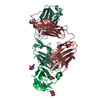


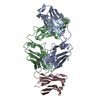
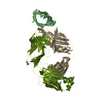
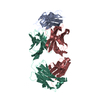

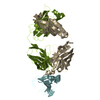
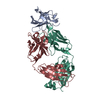
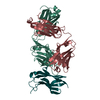
 PDBj
PDBj












